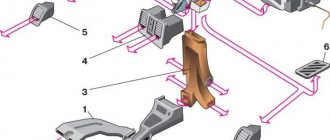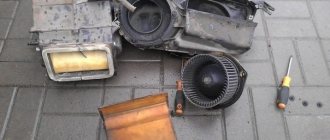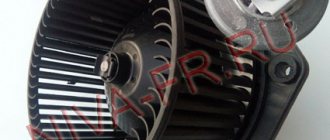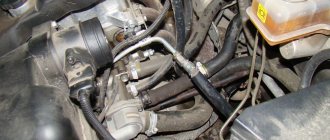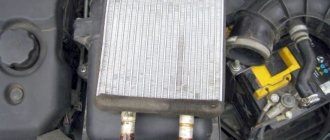The VAZ 2110 stove is perhaps the most problematic and capricious mechanism in the entire car design. You cannot do without a stove or a faulty interior heater radiator on a VAZ 2110, given our cold climate. If in the summer a non-working stove may not bother you, then with the onset of the cold season it often turns out that the stove on the VAZ-2110 is blowing cold air. Today we will try to talk in great detail about the design, repair and replacement of the heater on the “ten”. For clarity, we will supplement the text with photographs and videos. Let’s say right away that the design of the heating system on the “ten” is fundamentally different from what was on the old VAZ models. The most important feature and difference of the interior heater is that the VAZ 2110 heater radiator and its fan are located not in the cabin, but in the engine compartment. This design has its advantages, for example, to replace the heater radiator or stove fan, you do not need to completely disassemble the front panel (dashboard).
Another important difference is the electronic control of climate processes in the cabin. For this purpose, the VAZ 2110 is equipped with a so-called automatic heater control system (AHC). Photo of the SAUO block below.
By the way, the SAUO unit on “tens” of different years of production varies. Since 1996, 4 types of SAUO controller have been produced. It is worth taking this into account when purchasing a unit as a spare part. It is this device that controls the temperature in the cabin and the operation of the fan. You can set the temperature from 16 to 28 degrees.
But how does this miracle device work? On the ceiling of the “tens” cabin there is a temperature sensor or a ceiling air sensor with a built-in (very small) fan for air circulation. It is this sensor that sends information about the actual temperature in the cabin, and the SAUO unit gives a command to the micro gearmotor (MMR), which in turn opens or closes the main damper, which is responsible for the access of hot air to the cabin. When the temperature in the cabin changes, the ceiling sensor gives a new signal, the micro-gear motor is activated, turning the damper, closing or opening the access of hot air to the cabin. This way the set temperature is automatically maintained. Next is a photo of the VAZ 2110 heater air duct diagram .
Heater damper VAZ 2110: causes of malfunctions and repairs
On the VAZ of the tenth family, which includes the VAZ 2110-2112 models, the designers used an electronically controlled internal heating system, thanks to which the temperature set by the driver is maintained automatically.
On the VAZ-2110, instead of a manual heater control mechanism with a cable drive, the main elements are: a coolant supply shut-off valve and dampers, an automatic heater control system (AHC) controller with a temperature sensor and gear motors that regulate the position of the blinds.
This type of furnace no longer uses an antifreeze shut-off valve, and the heater operating mode - “heating” or “ventilation” - is controlled by a central damper, which directs the air flow through the radiator or bypassing it.
How malfunctions manifest themselves
The automatic temperature maintenance system used on the VAZ-2110 is more convenient in terms of control, since the automatic control system does everything independently, but is less reliable than a mechanical cable drive. Moreover, problems are caused by the electronic and electrical components of the stove - the controller, temperature sensor and micromotor gearbox, the central damper, which regulates the air supply to the cabin from the outside.
Problems with the operation of the VAZ-2110 heater related to the damper:
- lack of temperature control (only hot or cold air comes from the stove) regardless of the position of the handle on the controller;
- insufficient air heating (even when setting the handle to the maximum temperature);
- squeaks, knocks and extraneous noises after setting the temperature.
The cause of such problems is the central damper of the VAZ-2110 stove, which is adjusted by the controller through a gearbox. The design of the stove includes another damper - air distribution into zones. It is controlled using a handle mounted on the central air supply deflector into the cabin, so malfunctions with this part are rare.
Depending on the design of the stove, the damper may cause a disruption in the efficient operation of the heater for the following reasons:
- deformation;
- wear of seals;
- deterioration or damage to control levers and rods;
- skew.
To ensure tightness, the dampers have seals that reduce air leakage. Initially, foam rubber seals were used, which quickly wore out and became damaged. Later, foam rubber was replaced with rubber, but this only extended the service life of the seal; over time, the rubber ages, cracks and collapses.
On old-style stoves, rods and levers may break. On new heaters, there is another problem - wear on the edges of the square end of the gearbox, with which it is inserted into the groove made in the damper axis. As a result, the limit switch bypasses the groove, and the heater damper jams, although the gearmotor operates. The misalignment occurs due to the displacement of the damper axis in the mounting holes of the housing. Because of this, the damper warps and jams when opening.
How the stove works on a VAZ 2110
Problems in the operation of the heating system on the VAZ "Ten" arise quite often. For this reason, owners of this car from the domestic automobile industry need to devote a lot of time to solving the problem or contact service center specialists for help and payment for repairs.
To understand how to repair a VAZ 2110 heater and carry out preventive measures, you must first think about what parts it is made of.
In addition, this unit includes many other components - valves, fittings and other elements combined into one unit. The unit is enclosed in a housing and placed under the hood near the dashboard.
The design and principle of operation of the cooling system of the “tens” engine.
Any cooling system is designed not only to cool parts, but also to perform some other functions, namely:
- ventilation and air conditioning, heating the air in the heating system;
- cooling air in the turbocharger;
- cooling the working fluid in the automatic transmission;
- cooling the lubricant, or rather the oil in this system.
Design of the cooling system of the VAZ 2110 injection engine.
- Heater radiator
- Heater radiator steam hose
- Outlet hose
- Supply hose
- Coolant temperature sensor (in the cylinder head)
- Pump inlet hose
- Thermostat
- Charging hose
- Expansion tank plug
- Coolant level indicator sensor
- Expansion tank
- Outlet pipe
- Carburetor starter fluid chamber
- Radiator outlet hose
- Radiator inlet hose
- Radiator steam hose
- Left radiator tank
- Electric fan switch sensor
- Fan motor
- Electric fan impeller
- Right radiator tank
- Drain plug
- Electric fan shroud
- Timing belt
- Coolant pump impeller
- Coolant pump inlet pipe
- Coolant supply hose to throttle body
- Coolant drain hose from throttle pipe
- Exhaust coolant temperature sensor
- Radiator tubes
- Radiator core
The principle of operation of the cooling system of an injection engine.
If we talk directly about the cooling system of the VAZ 2110, then it is liquid, its circulation occurs forcibly, and is filled into the expansion tank.
The basis for creating the liquid used in this system is water combined with ethylene glycol. Such a liquid can freeze only at the lowest possible temperatures, and also create an elevated boiling point. By adding various additives to it, you can increase the service life of the oil seal, as well as slow down the process of corrosion of the system itself. Full filling of liquid requires the latter in a volume of 7.8 liters.
The movement of liquid throughout the cooling system of the VAZ 2110 injector is ensured by a centrifugal pump, which is fixed in the cylinder block and is activated by the timing belt.
As you know, the liquid gradually heats up from the friction of the working surfaces of the parts. And depending on the reached temperature of the liquid, the cooling system initially circulates in a small circle, and after heating it begins to move in a large circle. That is, when a certain heating point is reached, the thermostat is triggered, after which it opens and changes the direction of movement of the liquid. This process is already regulated by a pair of valves located in this thermostat. In it, the bypass valve regulates the movement of coolant in a small circle, and the main valve in a large circle. Thus, when one of these valves opens, the other closes, and vice versa.
Until the engine warms up well, the bypass valve is in the open position, and the coolant flows in a small circle through the cylinder block, throttle valve and heater radiator. This heating radiator is built directly into the engine cooling system, therefore, when liquid passes through it, the car interior is heated.
At the moment when the coolant is heated to 85°C, the main thermostat valve begins to open when the bypass valve closes. At this moment, the coolant flows simultaneously through both the small and large circles. And already at 102°C, the liquid enters the radiator, flowing only in a large circle. There, thanks to the flow of air from the outside, it is cooled.
It turns out that the injection system of the VAZ 2110 engine is designed in such a way that if the air flow does not cool the liquid well, then the fan is automatically turned on using a signal from the electronic control unit. And in the case of strong heating of the liquid, its volume begins to increase, and then its excess returns back to the expansion tank. This tank contains a valve that maintains the required pressure in the system.
It is necessary to monitor and check the coolant level only when the car’s power unit is cold. If you notice a regular decrease in it, be sure to check the entire system for leaks. Well, a complete replacement of the coolant in the VAZ 2110 injector must be done every 75,000 kilometers.
VAZ 2110 stove, heater, fan, dampers, video of replacing the VAZ 2110 stove radiator
The VAZ 2110 stove is perhaps the most problematic and capricious mechanism in the entire car design. A VAZ 2110 cannot be avoided without a faulty internal heater of the stove or radiator, given our cold climate. If in the summer a non-working stove may not bother you, then with the onset of cold weather it often turns out that the stove on the VAZ-2110 blows cold air. Today we will try to tell you in detail about the design, repair and replacement of heating elements in the “top ten”. For clarity, we will supplement the text with photos and videos.
Let’s say right away that the design of the heating system in the “ten” is fundamentally different from what was on the old VAZ models. The most important feature and difference of the internal heater is that the radiator of the VAZ 2110 heater and its fan are located not in the passenger compartment, but in the engine compartment. This design has its advantages, for example, to replace a heating radiator or stove fan, you do not need to completely disassemble the front panel (instrument panel).
Another important difference is the electronic control of climate processes in the cabin. To do this, the VAZ 2110 is equipped with a so-called automatic heater control system (AHC). Photo of the SAUO block below.
By the way, the SAUO unit on the “ten” of several years of production is different. Since 1996, 4 types of SAUO controllers have been produced. This should be taken into account when purchasing the unit as a spare part. It is this device that controls the temperature in the cabin and the operation of the fan. The temperature can be set from 16 to 28 degrees.
But how does this miracle device work? On the ceiling of the Dozen cabin there is a temperature sensor or ceiling air sensor with a built-in (very small) fan for air circulation. It is this sensor that sends information about the actual temperature in the cabin, and the SAUO unit gives a command to the micromotor gearbox (MMP), which, in turn, opens or closes the main damper, which is responsible for the access of hot air to the cabin. When the temperature in the cabin changes, the ceiling sensor sends a new signal, the micromotor-gearbox is activated by turning the damper, closing or opening the access of hot air into the cabin. Thus, the set temperature regime is maintained automatically. Also photo of the VAZ 2110 heater air duct diagram.
Principle of operation
The operating principle of such a control system is simple - the driver uses the left handle to set the desired temperature (completely cold or in the range from 16 to 28 degrees). Based on the set mode, the controller supplies power to the micromotor gearbox and it sets the dampers to the desired position.
Two-way communication is used between these elements - a position sensor is installed on the gearbox, which “informs” the controller about the opening angle. Thanks to the installed temperature sensor (located on the ceiling), the controller constantly monitors the degree of heating of the air in the cabin, based on which it adjusts the position of the damper to maintain the temperature set by the driver.
Temperature sensor VAZ 2110
Thanks to the use of automatic control system, the driver no longer needs to adjust the operation of the stove in order to maintain a comfortable temperature; he sets the temperature with a handle, and the controller does the rest. On the early VAZ-2110, the heater fan had three operating modes, the difference between which comes down to the rotation speed. Speed adjustment is carried out by installing a rheostat block in the power supply circuit of the electric motor. Then models appeared in which the fan received a 4th operating mode - automatic. When it is turned on, the fan operates under the control of the controller - the ACS regulates the rotation speed of the electric motor to adjust the temperature in the cabin.
The use of electromechanical control on the VAZ-2110 increased the convenience of controlling interior heating, but due to the more complex design, the likelihood of stove failure increased.
Connecting the VAZ 2110 stove - Do-it-yourself car repair
Car heating systems often fail in winter. During this period, the stove is used much more often, which means that all the weak points of this device appear. The control unit for the VAZ-2110 stove often fails, as do other elements of the system. Today we will pay special attention to this node.
Design of the heating system VAZ-2110
It includes three main nodes. This is a control unit for the VAZ-2110 stove, an air duct system, and a heating unit. The oven is controlled by an electronic unit. It consists of knobs with which the driver sets the desired temperature and fan intensity. The unit also includes a temperature sensor.
As for the latter, it is necessary to automatically start the stove when the temperature inside the car drops more than two degrees below the set one. The sensor is equipped with a small fan. If you move the control knob to position A, a small electric motor in the heating block will start, which operates the damper.
The temperature sensor itself in the VAZ-2110 is located on the ceiling, near the lighting lamp.
Another important element of the heating system is air ducts. They are launched directly from the furnace itself, and each channel performs its own separate function. Therefore, the central channels are designed for internal ventilation.
The air distributor is responsible for supplying fresh air to the cabin for ventilation or hot air for heating. The other two air ducts are designed to heat the rear passenger compartment. The rest is also intended for ventilation. Two side channels heat the mirrors and part of the interior. Separate nozzles are used to heat the driver's feet.
Block responsible for temperature
The central unit of the stove system is the heating block, the function of which is to directly heat the interior. This block is organized as follows. An electric motor with fan blades pumps hot air, three dampers perform the function of recirculation and closing / opening of channels. There is also a radiator.
In modern new generation systems, heat exchangers do not have a valve. Therefore, the radiator is always hot, regardless of the time of year. The manufacturer claims that this solved the problem with the constant leakage of the faucet. In addition, heating of the interior is significantly faster. In summer, the supply ventilation comes out of the radiator.
Typical faults
In summer, problems with the stove are very difficult to detect. Practically not used for its intended purpose. With the onset of winter, the question of the efficiency of the heating system becomes more pressing. Let's look at the typical faults that VAZ-2110 owners most often encounter. In case of serious problems, only replacing the VAZ-2110 stove can be an effective solution.
If the mechanism is not working efficiently, the first thing you need to do is check the amount of coolant. They look at the expansion tank - there are warning signs and a system lock indicator on it. If there is not enough liquid, add more. Sometimes even after topping up, the coolant level drops. This may indicate leaks.
Modernization of the damper on the VAZ-2110
Malfunctions with the damper often result in the interior heating very poorly and slowly. The error is the VAZ-2110 heater control unit. The controller is not working properly. The device does not issue a command to extend the flap. In this case, it is recommended to check the temperature sensor.
The controller handle is set to its extreme position and then unscrewed several times from left to right. The air flow temperature must be adjusted manually. In this way, the operating condition of the sensor is checked in one of the extreme positions of the handle.
If the air flow changes the temperature in the extreme position of the knob, the sensor must be replaced. If warming does not change, the cause must be looked elsewhere.
Block responsible for temperature
The VAZ heater radiator is located below the dashboard and has a plastic casing. It contains two plastic tanks (one of them, the left one, has a fitting for steam removal) and two rows of aluminum tubes with plates. Depending on how the dampers are located, a variable flow of intake air is passed through the radiator (in the extreme positions of the dampers all the air passes or does not pass at all), and the rest of the air is directed to the air vents and bypasses the radiator. The VAZ 2110 stove of the new model is controlled by signals coming from the electronic unit.
The unit receives information about the temperature in the cabin from a sensor located on the ceiling and equipped with a microfan. If necessary, the unit can operate a micromotor that controls the heater dampers. The electric micromotor has a heater damper position sensor (ring resistor).
Information from this sensor is sent to the control unit, which turns off the micromotor if the damper reaches the specified position. The new VAZ heating system has an automatic mode (position “A”), in which the control unit provides, in addition to monitoring the engine gearbox, also control of fan rotation.
How the VAZ-2112 stove works
Driver comfort is largely determined by the normal operation of the stove. In VAZs, it is this system that most often fails, and in order to quickly solve the problem, you need to become familiar with the design of the stove, understand its circuit and have a good understanding of the principle of operation. In this article we will talk about the heating system of the VAZ-2112.
Driving comfort in winter depends on proper operation of the stove
Device diagram with all explanations
The operation diagram of the VAZ-2110 stove can tell the motorist about the presence of recirculation in it, in other words, moving air flows circulate inside the car without taking new volumes of air from the street. Thanks to this, dust and unpleasant odors, which are present in large quantities in the street air, do not enter the unit. However, it is worth noting the main drawback of such a system - the windows fog up too quickly. Experts recommend opening windows often (at a comfortable temperature outside). Otherwise, the stagnant air will negatively affect the health of everyone involved in driving this car. Due to the complexity of repair, the gearmotor must be completely replaced in case of malfunctions.
How the oven works
VAZ 2110 models of the first years of production are equipped with an old-fashioned stove.
You should know that the design of the old-fashioned VAZ 2110 stove does not differ significantly from the new version, regardless of the power unit used, with the exception of a few points that will be discussed below:
- even micro gearboxes are different. Older elements have slightly different resistors. Therefore, before starting repair work, make sure that the appliances are truly interchangeable, and that you purchased old heating elements for the old version of the oven, and not new ones. Otherwise, difficulties will arise with the functioning of this element.
- radiator design. The main difference between ovens is this. So, if you intend to install a new radiator instead of an outdated version, then you need to take into account some installation nuances;
- The controller handle on the devices is slightly different. Old technology has a serious drawback: it is no longer produced. For this reason, position controls 4 and 5 manufactured before 2004 are not suitable for a new oven;
How to fix a stove
As already mentioned, the heating systems on VAZ 2110 models are practically no different from each other in design. And it doesn’t matter which engine is under the hood: carburetor or injection.
So the repair manual described below can be used by all owners of “dozens” of VAZs.”
If you are planning a major overhaul of a stove manufactured before 2003, we recommend purchasing a radiator first. A copper element is more suitable as it is more efficient and allows the stove to perform better.
Repair
As we have already noted, the design of stoves on dozens with carburetor and injection engines has practically no differences. Therefore, the repair instructions below are suitable for owners of a VAZ 2110 with both types of power units.
If you are planning to overhaul your old-style stove, we recommend starting with the purchase of a radiator. Use copper as it is more efficient and helps the heater work better.
To carry out repairs correctly, strictly follow the points presented in our instructions and rely on video materials.
- There is a plug on the engine block through which coolant is drained into any container. If you plan to use the same antifreeze or antifreeze again, choose clean containers.
- Next you need to move the frill forward. This process will take quite a long time, so be patient.
- Next, you need to remove the windshield wipers and get rid of as much as possible of everything that could interfere with the repair process.
- Remove the body of your stove. It is divided into two parts, which is important to know in advance. The front part of the stove body is removed directly along with the fan.
- After this comes the stage of dismantling the cabin filter. Check its current status. If the filter is dirty, this is an excellent reason to replace it.
- The next stage involves removing the second part of the housing.
- Loosen the clamps used on the hoses a little. This will allow you to easily remove the hoses.
- Having applied some effort, you can now finally remove the radiator from its seat.
Problem solving
Now let's talk about how to troubleshoot problems that arise, troubleshoot problems, and return the heater to normal operation.
Each breakdown requires separate consideration.
Temperature not regulated
If it is not possible to regulate the temperature of the air flow, the problem lies in the control unit or damper, or the temperature sensor on the ceiling inside the cabin does not work.
To check, turn the control all the way to the right and place your hand under the air stream. If hot air only flows when the control is in the maximum heating position, replace the sensor. If this does not help, replace the regulator. When heat is transferred to other places on the controller, the sensor should not be at fault.
Be sure to check that the shock is not blocked. You can get to it through the engine compartment. If replacement is required, replace the standard plastic curtain with an aluminum one. It's more durable.
Blowing cold
If the heater on your VAZ 2110 starts blowing cold air, then you need to look for the reasons. The reason for the failure lies in the gear motor. A similar situation occurs in 9 out of 10 cases, so it is unlikely that you will have to look for alternative culprits.
The gear motor must be replaced. This is done as follows:
- The fringe and windshield wipers are back in place. Job is done.
- Wipers removed;
- Unscrew the three screws holding the gear motor;
- The ruffle is dismantled;
- Disconnect the wiring;
- A new one is installed in place of the failed device. Ask an assistant to change the position modes of the regulator and at this time you will install the gear motor;
But there is 1 case out of 10 that will force you to change the heater due to wear and tear of the old one. As the practice of VAZ 2110 owners shows, the heater from 2112 is more suitable for replacement. In addition, you can choose between two stove options: 2112-01 or 2112-02. The first option is without an air filter, and the second option is without it.
The windows fog up, the feet are not heated
VAZ models often have a problem when the air comes out of the stove normally, but does not warm the feet and does not go into the glass.
The problem can be solved by updating the air ducts and eliminating existing cracks in the cabin and hot air ducts. This is a rather complicated procedure, the implementation of which will allow you to forget for a long time about the problem with the stove, which does not heat the legs and does not blow up the side windows.
It would not be superfluous to mount a pre-heater. Due to this, the interior heats up faster.
Replacing the gearmotor
If the damper does not work, hot or cold air blows from the heater, and the ability to adjust it is lost. In such a situation, the cabin heater gearmotor must be replaced.
Replacing the damper on a Priora begins with raising the hood and removing the wipers. To do this, remove the plastic caps and unscrew the nuts with a 14 wrench, after which they are easily removed. Next, the left and right frills are dismantled by removing the rubber pad, protective plastic caps and unscrewing six screws. Then the plastic soundproofing of the engine compartment is removed, the cooling system hose passing through it is carefully disconnected from the expansion tank, then the tank itself is removed. To avoid draining the coolant, the holes in it must be plugged.
To inspect the heater gear motor, remove the expansion tank mounting bracket by unscrewing two bolts under the wing and removing the protection above the left front wheel. After this, the wiper motor and trapezoid are dismantled.
Now the unit is being dismantled; first you need to carefully disconnect the heater damper sensor and the power supply contacts. After this, install and check the new spare part, reassemble everything in the reverse order, and the replacement of the stove gear motor is completed.
Components and processes of the VAZ-2112 heater
- resistor;
- electro-pneumatic valve;
- damper on the stove channel;
- recirculation flap control valve;
- radiator and its casing;
- stove control damper;
- water-reflecting air intake deflector;
- fittings for steam outlet and supply pipelines;
- cover from the stove lining.
- casing from the air intake of the heating system, consisting of front and rear parts;
- micromotor-gearbox with damper control;
- stove motor in the housing and fan;
- support platform for the heater control hatch activation lever and the lever itself;
- recirculation deflector on the air intake;
The radiator is located horizontally under the instrument panel. It is enclosed in a plastic case. The radiator design includes two plastic tanks and a pair of aluminum tubes on which plates are molded. There is a steam outlet on the left side of the tank. The passage of intake air through the radiator depends on the position of the dampers. If the shock absorbers are in the extreme position, all the air flow may pass through the radiator or not at all.
Lack of tap - plus or minus?
While older VAZ models have a tap that can be used to shut off the supply of antifreeze to the radiator, the VAZ-2112 is not equipped with such an element. If the engine is running, the radiator heats up regardless of the time of year. This design feature of the stove makes it possible to achieve a small inertia, which is inherent in the system when starting up. In other words, the required temperature will be reached in a shorter time. Additionally, the user will not have to deal with leaks that occur as a result of a leaking faucet. The electronic control unit, which generates the necessary commands, is responsible for the ability to conveniently control the operation of the stove.
Assembly of the unit
Interchangeability of gearmotors
When the work to restore the functionality of the MMR is completed, install it in place. For this:
- Insert the pin of the micromotor-reducer lever into the slot of the lever. It is located on the damper drive;
- If the lever is not turned properly, apply 12V voltage to the motor connector pins using two wires. We are talking about yellow wires here. This way you can return the lever to the correct position;
- Having installed the micromotor-reducer, check it for operability, plus watch how the damper drive of your heater moves, whether the heater control lever “plows” properly to regulate the temperature.
We will repair or replace the damper and heater drive, you will be able to return the heater to its previous functionality and independently determine what temperature regime will be set inside the cabin of your VAZ 2110.
We are finishing the VAZ-2110 heater. Manual control
And there is no guarantee that the new one will work happily ever after. But replacement is a troublesome and expensive task: the unit costs about 550 rubles.
So this embarrassment happened at the editorial “top ten” (see the material “Last Year’s Snow” - ZR, 2006, No. 3).
The simplest and most effective way to restore acceptable interior heating was to insert a figure-of-eight valve into the heater pipe (see photo). The work takes only 15 minutes, and all you need is a knife and pliers. The valve control cable (the control cable for the air damper of a Zhiguli carburetor is suitable) can be conveniently brought into the cabin under the steering column. The air damper of the “tens” heater must be secured in the “hot” position. Access to it is with a long screwdriver through the removed air duct grille in the center of the instrument panel (“dashboard”).
To restore the heating control that is natural for the “ten,” instead of an unreliable electric drive, we installed a blind control cable from a GAZ truck, adjusting it to its length. Oh, the Bychka heater cable fits, but its price, like the gear motor, is 550 rubles...
The mechanical control of the damper fits the “ten” so well, as if this option was included in the design from the very beginning.
We remove the frill and the faulty gear motor, saw off the square shaft from it. We make a lever from metal, and a clamp from an M8 bolt (see figure).
We drill a hole in the panel and fasten a cable pre-adjusted to its length in it (we cut the cable sheath so that it serves as a limiter for turning the lever).
We insert a piece of the square shaft of the gearmotor into the damper axis, put a lever and clamp on it, insert the cable into the hole in the clamp, turn the damper to the “warm” position (the cable is recessed) and fix it.
Now the manual damper will last forever.
Description of the heating system on "Dvenashka"
In VAZ 2112 cars, supply and exhaust ventilation is used. In this case, the air flow enters through special holes that are located in the windshield lining. The air itself can be supplied forcefully, under the influence of a heater fan, or arbitrarily. Air flows out of the cabin through gaps located between the door panels, as well as at their ends. Special valves are built into these openings that allow air to escape and also delay its entry, improving the thermal insulation of the cabin.
Where does the noise in the top ten come from?
The main sources of noise in the cabin of the 2110 and methods for eliminating them, schematically, are given below:
- noise from the engine compartment can be eliminated by insulating the engine shield and floor with special materials, of which there are plenty on sale;
- noise from wheels and from road gravel and dust can also be removed in several ways - with noise-insulating mastic, plastic fender liners coated with Bimast, or the combined use of both;
- Aerodynamic noise is the most difficult to eliminate, since in this case you will have to set all the gaps between the body panels and the hood, doors, and wings to their nominal value, and this is not so simple and not so effective.
Design Features
The VAZ 2110 provides for the installation of two types of stoves - a new model and an old one. Regardless of the engine used (injection or carburetor), there are no fundamental differences in the design of the stove.
But what is the difference between new and old stoves? Let's try to figure it out.
- Since September 2003, several micromotor gearboxes have been installed in the furnaces. The difference lies in the shaft position sensors (resistances). Therefore, when repairing, make sure that the devices are truly interchangeable and that you purchased old-fashioned resistors for your old stove, and not a new one. Otherwise, the gear motor will not work.
- Radiator design. This is the main difference between the devices. Therefore, when replacing a radiator from an old one to a new one, be sure to take into account the installation nuances;
- The controller knob on the plates is slightly different. There's a big problem with old-fashioned heaters: They're out of production. They cannot be analogues of 4- and 5-position regulators, which began to be supplied in dozens in the fall of 2003;
Replacement and modification of the stove
If there is a poor supply of warm air due to the fault of the air duct, a small modernization of the VAZ stove and air channels suggests itself. Refinement is carried out in two ways: by installing a system of corrugated hoses and by insulating the side panels, which mainly involves sealing cracks and gaps. Corrugations are used with a diameter of 40 mm, and the cracks are sealed with polyurethane foam.
The VAZ heating system, if installed before 2006, has old-style stoves. In this regard, it is advisable to replace it with a new type of stove. Thus, heaters 2112-01 and 2112-02 proved to be quite effective. Preheaters can be installed to speed up heating. It should be noted the features of replacing the VAZ 2110 injector heating, which is increasingly being installed on cars.
The main content of such a system is the installation of a 6-hole thermostat to replace the standard one in the engine cooling system. Prevention of good operation of the heating system may include drastic measures:
- replacing the heater with a new type stove;
- modification and modernization of the VAZ stove;
- change in control scheme;
- new heating system VAZ 2110 injector.
It is very unpleasant to be in a car when it is cold inside. Independent adjustment and fine-tuning of the VAZ stove will provide the necessary comfort.
If you decide to repair your car yourself, you need to have a good knowledge of its components and be able to read drawings. Of course, such skills come with experience in operating and maintaining the VAZ 2110. This time we will study the operation of the heater in detail. If the heating system functions properly, then both the driver and his companions will be comfortable inside the “ten”. This material contains stove diagrams and descriptions for them. The instruction manual also contains this information, but we try to describe complex processes in simple language. Our task is to convey important information to beginners and experienced motorists.
Heating device design
The heating of the VAZ-2110, thanks to which a motorist can feel comfortable in his mobile property at any time of the year, consists of several separate devices that work in close contact. The central device of the unit is the radiator, with the help of which the air flows entering the cabin are heated. In order to repair or replace the radiator, you will have to look for ways to get under the hood.
The second most important device can be called an air distributor, in which several nozzles operate in the “ten” of the cabin. Compared to the old-fashioned models that preceded the release of the VAZ-2110, the new car has an evaporator that has found a place in the air conditioning system.
The operation of the stove is controlled by a special control unit. In the VAZ-2110 operating instructions, this device has a different name (controller). The unit works in conjunction with a temperature sensor located in the cabin. The sensor transmits temperature information to the unit, after which the data is compared (the information displayed on the handle is taken into account). As soon as the system detects a temperature difference of 2°, hot or cooled air is immediately supplied to the cabin.
To understand how the heating element works, you need to pay attention to the handle of the device; Two extreme positions deserve special attention: MAX and MIN. The fact is that when you set the knob to one of these indicators, the system begins to give off heat, not taking into account the data from the temperature sensor.
The VAZ-2110 stove includes a device such as a gear motor. The task of this device is to open and close the damper. The small electric motor is extremely important in the operation of the heater. Even with a minor malfunction of the gear motor, the system will be able to supply the car owner with either only cold or only hot air. If this device fails when the damper is closed, the entire system will cease to perform its function. Main components of the heating device:
- gear motor.
- radiator;
- SUAO block;
- ceiling sensor;
- lever arm;
- a device that distributes air flows;
- shock absorber;
Purpose of the radiator
The VAZ-2110 stove of the new model has a radiator through which the air entering the car is heated. Quite often on the global network you can find diagrams in which the radiator is designated as a heat exchanger. The heating process in the device occurs due to the flow of hot antifreeze. The radiator is connected to the cooling system of the power unit through several pipes and hoses. The refrigerant circulates continuously inside the heat exchanger. The position of the damper determines the volume of incoming air and its direction. When the heater damper is in an intermediate position, part of the air passes through the heat exchanger, and the remaining volume bypasses the radiator. The diagram shows that the new radiator design differs from other models in several useful improvements.
Common faults
Most often, the VAZ 2110 suffers in terms of heating because the heater adjustment, as they say, does not work. Regardless of the selected position of the temperature control knob, only cold or, conversely, only hot air blows from the heater.
The reasons for this phenomenon may have different origins. Among them:
Jamming of the MMR (micromotor-reducer) that controls the damper drive; The plastic damper (the first VAZ 2110 was equipped with these) has a destroyed seat, and due to jamming it is impossible to control it normally. If the gearbox is working, but the damper does not turn, you can most often hear peculiar clicks - this is the square shaft turning in the socket. For such a malfunction, there is only one treatment - replacing the old plastic damper with foam insulation with a new one. Better, more modern, metal, with a rubber seal
This one does not warp or warp like its plastic sister; To finally decide who to blame - the damper or the MMR, you still need to pay attention to its control unit. He is also among the “suspects”.
Car chip tuning
Chip tuning is nothing more than reprogramming the engine control system. The entire farm is managed by a special controller. Changes in the operation of electronics are achieved by either completely replacing the memory chip or reprogramming it. This controller has been calibrated at the factory to the average machine performance. To be able to influence various characteristics, fuel consumption and much more, just change the calibration.
Programmers and electronics engineers who deal with these problems have created the necessary programs for chip tuning. Some of the most popular calibration settings are “sport” and “economy”. The first is designed for dynamic driving in the city or on the highway, with a slight increase in fuel consumption. The “economy” mode allows you to drive a car in city conditions more economically.

